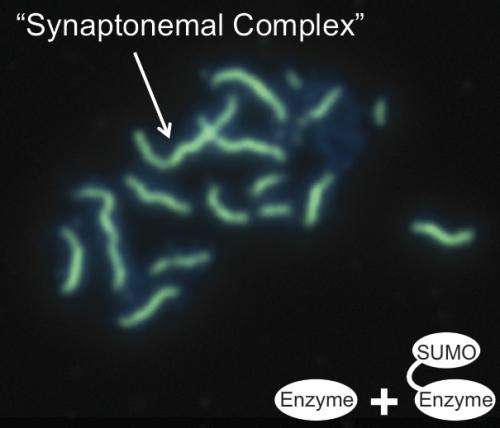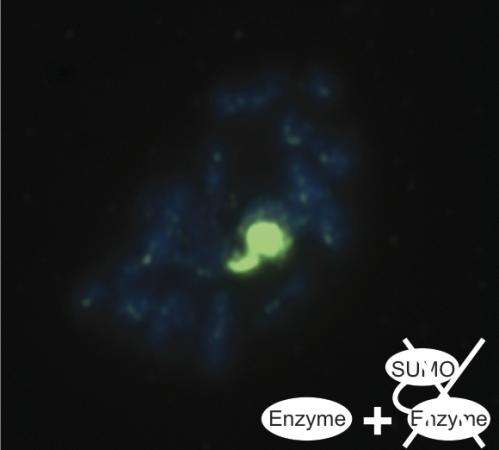New mechanism discovered in meiosis

Inactivated, but still active– how modification of an enzyme governs critical processes in sexual reproduction.
The Research Group headed by molecular biologist Andrea Pichler from the Max Planck Institute of Immunobiology and Epigenetics in Freiburg has made an important discovery in meiosis research. Pichler and her group have identified a new mechanism that plays an important role in meiosis.
Starting point of the research
Meiosis, also called reductional division, is a key process in sexual reproduction. It shuffles parental genetic material and thus guarantees genetic variety.
In order to control various biological processes, cells are able to selectively alter properties of their proteins, such as their lifespan, activity level, binding partners, or localization of the proteins. This is accomplished, for example, by attaching one or more Small Ubiquitin-like Modifier (SUMO) proteins. This takes place in three sequential enzyme-dependent steps. Scientists have assumed that the enzyme for step 2 was solely an intermediate.
The breakthrough
As the scientists in Freiburg have now discovered, the step-2 enzyme is itself modified by the SUMO protein and thereby alters how it functions. The surprising effect: the conventional activity of the enzyme is switched off by this change and instead, a new function gained. It works together with the activated, unaltered enzyme in the formation of SUMO chains. If this effect is blocked, there are serious consequences: the protein structure (synaptonemal complex) that forms between the homologous chromosomes can no longer be established.

The researchers' new insights
A tiny amount – less than one percent – of the SUMO-modified step-2 enzyme is sufficient to form a normal protein structure (left image). Researcher Helene Klug from Pichler's team: "The smallest amount of the altered enzyme together with the unmodified enzyme is sufficient to form an activated complex, which then carries out the meiosis specific SUMO modifications."
"In the beginning, the results of the biological and biochemical experiments were completely contradictory, although the data were absolutely sound. We were therefore convinced that both sets of observations were correct. Explaining this contradiction led us then to the new mechanism", according to Pichler, who heads the study. In extensive and complicated biochemical experiments, the researchers were additionally able to reveal, for the first time, how this enzyme complex carries out the formation of SUMO chains.
After fifty years of research on the synaptonemal complex, these new insights are setting a new course: "This is the first time we can study the loss of the synaptonemal complex with practically no secondary effects and we hope to unveil its secret. That allows us to investigate the consequences for meiosis and thus for development of the gametes", say Franz Klein and Martin Xaver, collaborators and meiosis researchers at the Max F. Perutz Laboratories in Vienna.
Pichler and her team were already able to demonstrate in 2008 that self-tagging by the step-2 enzyme in mammalian cells has an influence on precisely which proteins are tagged with SUMO. In order to uncover the biological function for this form of regulation, the research team switched to baker's yeast (Saccharomyces cerevisiae), a simpler organism. "Now that we know where we need to search, we also want to switch back again to the mammalian system and investigate the role of this enzyme regulation more closely there", says Pichler. "In addition, we want to better understand the function of the discovered baker's yeast enzyme complex in the meiotic chromosomal structure."
Scientists at the Max Planck Institute of Immunobiology and Epigenetics (MPI-IE) in Freiburg, founded in 1961, investigate how the immune system has developed over the course of evolution and how it changes during life. The focus on epigenetics was added in 2007. Researchers in this area investigate changes to inheritable characteristics that are not based upon changes to the DNA sequence.
More information: Klug, H. et al. Ubc9 Sumoylation Controls SUMO Chain Formation and Meiotic Synapsis in Saccharomyces cerevisiae (2013). Molecular Cell, 2 May 2013. dx.doi.org/10.1016/j.molcel.2013.03.027
Journal information: Molecular Cell
Provided by Max Planck Society

















